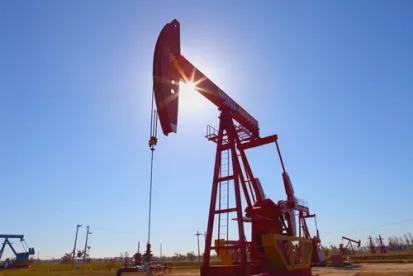Oilfield operators of every size have been busy implementing the Obama Administration’s labor-intensive requirements to detect and repair vapor leaks from well site equipment, often called the Quad Oa requirements, in reference to the federal rules at 40 CFR Part 60, Subpart OOOOa. On September 11, 2018, the U.S. Environmental Protection Agency (“EPA”) announced proposed changes to these new source performance standards (“NSPS”) applicable to oil and gas well vapor leaks (known as “fugitive emissions”).1 EPA’s proposed 2018 NSPS Rule would give operators more flexibility by allowing them to comply with certain state fugitive emissions requirements in lieu of federal requirements. The 2018 NSPS would also decrease the frequency of well site monitoring and extend the amount of time allowed for leak repairs. Additionally, the 2018 NSPS would clarify certain definitions for well site pneumatic pump standards and certification requirements.
These proposed changes would modify EPA’s August 2016 final rule, “Oil and Natural Gas Sector: Emission Standards for New, Reconstructed, and Modified Sources.” 81 Fed. Reg. 35,823 (Aug. 2, 2016) (codified at 40 C.F.R. Pt. 60). This 2016 NSPS Rule introduced fugitive emission standards for components at well sites and compressor stations to control the emission of methane, a potent greenhouse gas, and other volatile organic compounds (“VOCs”) emissions. Id. The following year, on April 4, 2017, EPA announced that it would review the 2016 NSPS requirements. 82 Fed. Reg. 16,331 (Apr. 4, 2017). EPA’s current 2018 NSPS proposal has been submitted for publication to the Federal Register. A final draft of the proposed rule is available on EPA’s website. See EPA, Oil and Natural Gas Sector: Emission Standards for New, Reconstructed, and Modified Sources Reconsideration. Following publication in the Federal Register, the EPA will accept comments on the 2018 NSPS for 60 days.
The most significant changes in the proposed 2018 NSPS Rule involve fugitive emissions monitoring and component repair requirements and the option to follow existing state monitoring and repair requirements in certain states, including Texas. “Fugitive emissions” refer to leaks that can occur at a well site or compressor station when the connections are not properly fitted, hatches are not properly weighted and sealed, or when seals and gaskets start to deteriorate. Overall, the proposed 2018 NSPS would streamline many fugitive emissions monitoring and repair requirements for well owners and operators.
I. The 2018 NSPS Decreases Fugitive Emissions Monitoring Frequency Requirements and Allows More Time for Repairs of Fugitive Emissions
Under EPA’s original 2016 NSPS, owners and operators were required to conduct an initial monitoring survey within 60 days of production, followed by semiannual monitoring for well sites and low production wells, and quarterly monitoring for compressor stations. 2018 NSPS, at 22–24. The new 2018 NSPS still maintains the requirement for initial monitoring within 60 days of production, but EPA is actively soliciting comments on whether to extend this to 90 or 180 days. Id. at 70. The biggest changes in the 2018 NSPS to monitoring frequency requirements apply across the board: wells sites can now be monitored annually (instead of semiannually); low production wells that have a combined oil and natural gas production of less than 15 barrels of oil equivalent per day averaged over the first 30 days of production can now be monitored every two years (instead of semiannually); and compressor stations can now be monitored semiannually (instead of quarterly). Furthermore, if all major production and processing equipment has been removed so that only wellheads remain, monitoring may be stopped entirely.2 These changes are summarized in the attached Table 1.
The proposed 2018 NSPS makes no changes to the monitoring technique requirements and definitions in the 2016 NSPS. The leak definition, or threshold for repair, remains unchanged at 500 parts per million (“ppm”). The monitoring instrument for detecting visible fugitive emissions is still optical gas imaging (OGI), and Method 21 of Appendix A-7 to Part 60 may still be used as an alternative monitoring method at a repair threshold level of 500 ppm. 2018 NSPS, at 22–24, 134.
However, the 2018 NSPS proposes significant changes to repair deadlines for fugitive emissions. The 2016 NSPS required owners and operators to repair leaks within 30 days after detection of fugitive emissions. 40 C.F.R. § 60.5397a(h)(1), (3). Owners and operators were then required to resurvey the leaking component within 30 days to confirm that the repair was successful. Id. Because these requirements created issues in cases of unsuccessfully repaired components, EPA is proposing changing these requirements. 2018 NSPS, at 9–10, 71–73.
Under the new 2018 NSPS Rule, owners and operators would now have up to 60 days after fugitive emissions are detected to complete repairs, though a first attempt at repair must be made within the first 30 days after detection. Id. A resurvey is no longer required, as that is now included in the final repair requirement. Id. These changes are summarized in the Attached Table 1.
Accordingly, EPA has added new definitions for “repaired” and “first attempt at repair” that apply specifically to fugitive emissions. Id. Repair is defined as, “fugitive emission components are adjusted, replaced, or otherwise altered, in order to eliminate fugitive emissions ... and it is verified that emissions from the fugitive emissions components are below the applicable fugitive emissions definition.” Id. First attempt at repair is defined as, “an action taken for the purpose of stopping or reducing fugitive emissions of methane or VOC to the atmosphere. First attempts at repair include ... where practicable and appropriate: tightening bonnet bolts; replacing bonnet bolts; tightening packing gland nuts; ensuring the thief hatch is properly seated or injecting lubricant into lubricated packing.” Id. at 71–72.
Furthermore, the 2016 NSPS allowed for a delay of repair to the next scheduled shutdown or within two years, whichever was earlier, if: (1) the repair was technically infeasible; (2) the repair would require a vent blowdown, a compressor station shutdown, a well shut-in, or a well shutdown; or (3) the repair was unsafe during the operation of the unit. 2016 NSPS, 35,858. Although the 2018 NSPS has not changed this requirement, the EPA is soliciting comments regarding the delay or repair deadlines as well as comments about whether to add a regulatory clarification on EPA’s position that thief hatches and other openings do not constitute vent blowdowns and so are not subject to delay of repair under any circumstance. Id.
II. The 2018 NSPS Rule Allows Well Sites to Comply with Certain State Fugitive Emissions Regulations, Including Texas’, In Lieu of Complying with Federal Regulations
In 2016, the EPA noted that no state fugitive emissions program was “at least equivalent” to the 2016 NSPS, and therefore owners and operators were not allowed to use state requirements as alternatives to EPA’s requirements. However, the EPA conducted an equivalency evaluation of multiple state fugitive emissions programs for the 2018 NSPS and decided to allow alternative state fugitive emission standards for certain states, including Texas. Under the 2018 NSPS, Texas3 well sites can now meet alternative state standards. Id. at 90, 144, 148. Notably, this alternative fugitive emission standard does not apply to Texas compressor stations.
Texas currently has different fugitive emission monitoring requirements depending on whether or not the site is located in one of the fifteen counties of the Barnett Shale formation. Sites not located within the Barnett Shale formation may obtain a Permit by Rule (“PBR”), a Standard Permit, or a case-by-case-permit incorporating monitoring requirements. The PBR applies to sites that emit less than 25 tons per year (“tpy”) of VOCs. See 30 TAC § 106.352(l). Sites not located on the Barnett Shale emitting greater than 25 tpy may apply for a Standard Permit, or a Case-by-Case Permit. The Standard Permit requirements can be found in either 30 TAC § 116.620 or in the Air Quality Standard Permit for Oil and Gas Handling and Production Facilities, section (e)(6), effective November 8, 2012. Sites located within the Barnett Shale may obtain a PBR under 30 TAC § 106.352 (a)-(k), or may obtain a Standard Permit under 30 TAC § 116.620.
The 2018 NSPS would now specifically allow an affected facility, as defined in 40 C.F.R. § 60.5430a, located at a well site, to elect to comply with the monitoring, repair, and recordkeeping requirements in Texas’ Standard Permit regulations, as an alternative to complying with the federal fugitive emissions monitoring and survey requirements (40 C.F.R.§ 60.5397a(f)(2), (g)(2) –(4)) and repairs (40 C.F.R.§ 60.5397a(h) and (i)). This is allowed so long as the monitoring instrument used is a Method 21 instrument and the leak definition used for Method 21 monitoring is an instrument reading of 2,000 ppm or greater. 2018 NSPS, at 90, 144, 148. Significantly, the 2018 NSPS does not allow a well to comply with a PBR as an alternative fugitive emissions standard because the PBR specify the instrument monitoring requirement. Therefore, only wells with Texas Standard Permits may elect to comply with Texas fugitive emissions requirements in lieu of the 2018 NSPS requirements.
Before implementing the alternative state fugitive emissions standard, an owner or operator must notify the EPA at least 90 days prior to implementation, and must maintain the records specified by the alternative standard for at least five years. Additionally, the 2018 NSPS Rule allows owners or operators to submit an application to the EPA for alternative state fugitive emissions requirements that will achieve at least equivalent emissions reductions of VOC and methane emissions as under the federal requirements. After notice and public comment regarding the application, the EPA would publish the determination in the Federal Register. 2018 NSPS, at 90, 144, 148.
Practically, the Texas Standard Permit fugitive emission requirements are stricter than the 2018 NSPS requirements, except for the leak definition and initial monitoring requirements. The leak definition in the Texas standard permits varies from 500 parts per million by volume (“ppmv”) to 10,000 ppmv based on the component, the site wide emissions, and the facility’s proximity to an off-plant receptor (e.g. residential areas). This is more flexible than the 2018 NSPS 500 ppm leak definition. Additionally, instead of the 60 day initial monitoring requirement in the 2018 NSPS, the Texas Standard Permit allows for 90 days.
However, the repair schedule under a Texas Standard Permit is far stricter than the 2018 NSPS. Under a Standard Permit, repair deadlines are based on the facility’s proximity to off-plant receptors. Repairs must typically be first attempted within 5 days after detection and be completed within 15 days, except for leaks of sulfur dioxide and hydrogen sulfide, which must commence repair 8 hours after detection. If technically infeasible, repairs may be conducted during the next scheduled shutdown. Well site monitoring frequency is also potentially more stringent under a Texas Standard Permit than under the 2018 NSPS. The Texas Standard Permit requires quarterly monitoring for well sites (as opposed to the 2018 NSPS annual or biennial monitoring requirements for wells), although this monitoring can be reduced to annual monitoring if the percentage of leaking valves is low.
Overall, EPA’s stated goal in allowing the alternative state fugitive emission standards is to create $380 million of total cost savings by “streamlin[ing] the process, ensur[ing] compliance, and reduc[ing] regulatory burdens.” EPA reports that the 2018 NSPS may have a negative impact on air quality due to an increase in VOC emissions, presumably caused by the extended time periods allowed to complete repairs and decreased fugitive emission monitoring frequency requirements. Thus, even though Texas’ requirements are stricter in certain regards, the regulatory burden on well sites operating under Standard Permits is reduced because the well sites need only comply with the permit they are already operating under. However, well sites not under a Standard Permit, or compressor stations, must still comply with the 2018 NSPS fugitive emissions requirements.
III. Technical infeasibility and engineer certification definitions are expanded for well site pneumatic pumps under the 2018 NSPS.
The 2016 NSPS created a distinction between greenfield sites and non-greenfield sites, defining a greenfield site as one other than a natural gas processing plant, which is entirely new construction. 81 Fed. Reg. 35,850. Under this distinction, the technical infeasibility exemption from well site pneumatic pump requirements was unavailable for greenfield sites. Id. This created ambiguity over the exact definition of a greenfield site and the applicability of the exemption. As a result, the 2018 NSPS removes the distinction between greenfield and non-greenfield sites for pneumatic pump requirements, expanding the technical infeasibility exemption to new and existing sites. 2018 NSPS, at 20–22. Furthermore, the 2016 NSPS required that technical infeasibility be determined and certified by a “qualified professional engineer” (“PE”). 40 C.F.R. § 60.5393a(b)(5)(i). In order to avoid the costs associated with licensed PEs, the 2018 NSPS now allows for certification by either a PE or an in-house engineer with expertise on the design and operation of pneumatic pumps. Id. This expanded certification also applies to the design evaluation and certification of closed vent systems under 40 C.F.R.§ 60.5411a(d). Id.

Courtesy of EPA Memorandum, Docket ID. No. EPA-HQ-OAR-2017-0483, April 12, 2018.
1Note that the Bureau of Land Management (“BLM”) has proposed similar fugitive emissions rollbacks under the Methane Waste Prevention Rule for wells located on BLM lands. More information can be found on BLM’s website at https://www.blm.gov/programs/energy-and-minerals/oil-and-gas/operations-and-production/methane-and-waste-prevention-rule.
2However, EPA notes that certain modifications of well sites, such as separate tank batteries, would still be subject to certain fugitive emissions requirements.
3The 2018 NSPS also allows compliance with the following state fugitive emission regulations in lieu of federal compliance: California (for well sites and compressor stations); Colorado (for well sites and compressor stations); Ohio (for well sites and compressor stations); Pennsylvania (for well sites and compressor stations); and Utah (for well sites).





 />i
/>i

